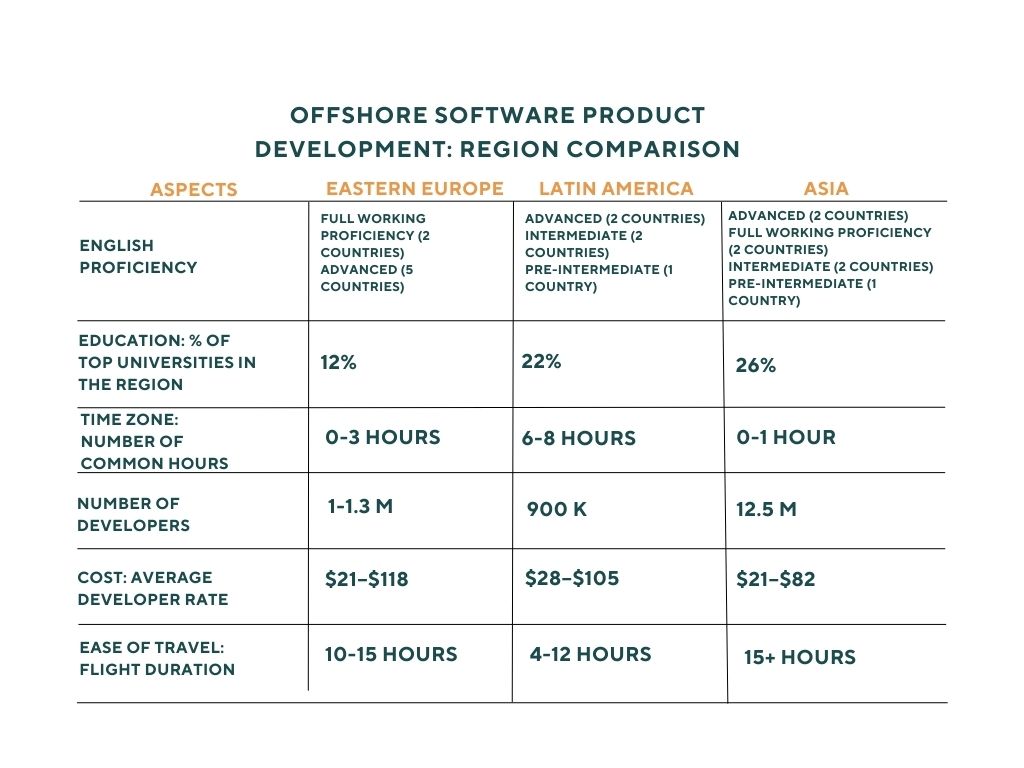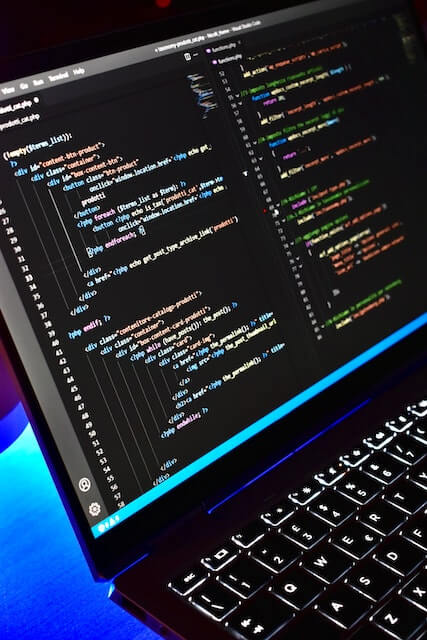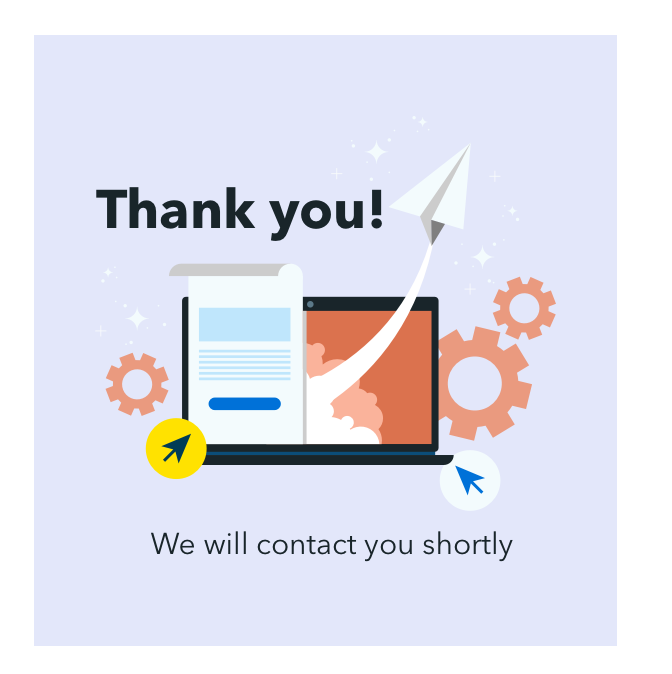
Offshore Product Development: Eastern Europe, Latin America or Asia?

Choosing the best destination to farm out your software product development can be challenging. As a company that builds tech teams for North American clients in Ukraine, we at nCube know for sure that lots of factors can affect your choice, from location and talent availability to ease of travel, English proficiency and offshore product development rates. With that in mind, we conducted this research in the hope that it will complement your own vision of the most suitable offshore development destination and help you size up the opportunities and potential challenges that await you in each location.
Offshore custom software development: Eastern Europe
The hallmark of Eastern Europe as an offshore IT development location is its reasonable quality to price ratio. Consisting mostly of developing countries, the region made great strides in improving its business climate and attracting investors in recent years. The region’s hotspots of offshore software product development are:
- Ukraine
- Poland
- Czech Republic
- Hungary
- Bulgaria
- Romania
- Belarus
- Moldova
Let’s review this region in more detail.
- Education
Education is a prime factor in driving the IT sector in Eastern Europe. In fact, 54 out of 454 top European universities are scattered across the countries of the region, which provides lots of opportunities to obtain advanced education in STEM disciplines. Overall, Eastern Europe boasts a solid system of tech education, yielding thousands of degree holders per year with a strong background in Mathematics and Engineering. For example, 95% of engineers at nCube are university degree holders who are successfully taking up offshore software product development opportunities for our US-based clients.
- Time Zone
The difference in time zone between Eastern Europe and North America can range from 5 to 12 hours ahead, allowing for a minimum of 3 hours overlap, which is a solid time window for real-time communication. In fact, many developers prefer to shift the start of their working day a few hours ahead for better synchronization with their offshore counterparts. Moreover, working with an offshore custom software development purveyor from this region fosters continuous development, as two teams separated by a 5-12-hour difference provide you significant coverage: In a 24-hour timeline, your local and offshore teams will work on your project, 8 hours each. This way, you get 16 hours of work on your project per day. That’s one of the key benefits of offshore software development in this region.
READ ALSO: How to Build an Offshore Software Development Center
- Developer availability
According to various sources, Eastern Europe boasts from 1M to 1.3M developers. Let’s take a look at the number of developers in our reviewed countries:
- Ukraine: 200,000 developers
- Poland: 250,000 developers
- Czech Republic: 100,000 developers
- Hungary: 80,000 developers
- Bulgaria: 66, 000 developers
- Romania: 77,000 developers
- Belarus: 32,000 developers
- Moldova: 13,000 developers
Most of these developers are involved in the export of offshore software product development services, which means they are already experienced in working with international companies.
- Cost
According to Accelerance, offshore software programming rates in Eastern Europe vary from $21 to $118. It’s worth mentioning that countries such as Ukraine, Moldova, and Bulgaria are more affordable due to lower cost of living. According to Clutch.com, an offshore software development firms aggregator, the average rate per hour for software development in Ukraine, Czech Republic, Bulgaria, Romania and Moldova is $25-49, not including taxes and fees associated with a provider of offshore software product development. In Poland and Hungary, such companies charge between $50-$99 for an hour of developer’s time.
- Culture fit
The culture that dominates the region can be best described as Western-like, with lifestyles and values akin to those prevailing in North America and Western Europe. It means that local developers have a strong work ethic, open mind, and a knack for innovative thinking. Offshore product development organizations maintain a laser focus on the client’s needs and transparency when it comes to processes and communication.
- Team visits
Eastern Europe’s tourist magnets like Kyiv, Warsaw, Budapest are known for their ambiance of historic cities with well-developed tourism infrastructure.
Visiting your offshore custom software development partner in Eastern Europe will be comfortable due to a variety of flight connections with major North American cities. The travel time between major cities in Eastern Europe and the East Coast is 10-12 hours, whereas it will take up to 15 hours to get to the West Coast of the US.
- English proficiency level
According to EF English Proficiency Index, the countries we review have obtained the following results:
- Ukraine: full working proficiency
- Poland: advanced
- Czech Republic: advanced
- Hungary: advanced
- Bulgaria: advanced
- Romania: advanced
- Moldova: full working proficiency
We should acknowledge that English proficiency among the population tends to be lower compared to the proficiency of software developers who have vast experience working with international clients. For example, located in Ukraine, where English skills are ranked as moderate/full working proficiency, we at nCube always source software developers who speak English confidently, as it’s crucial for building relationships in an offshore development setup.
Offshore custom software development: Latin America
The IT sector in Latin America has expanded exponentially in recent years. Similar to Eastern Europe, the key driver in this region is a growing pool of tech talent and as an added bonus, the proximity to North America. The hotspots of offshore IT development in this region are:
- Brazil
- Mexico
- Argentina
- Colombia
- Chile
Let’s take a closer look at what these countries can offer to a tech leader in search of an offshore software programming vendor.
- Education
According to the World’s top universities ranking, 99 out of 454 top universities are located across Brazil, Mexico, Argentina, Colombia, and Chile. Moreover, Argentina takes first place in the Global Skills Index according to 2019 Coursera research thanks to its best-in-class education system. To propel the industry to new heights, educational institutions in the region offer a wealth of courses in information technology. One such example is Plan Vive Digital, a program launched by the Colombian Ministry of Technology that has funded the training of over 6,000 students in 2018. Not only do such initiatives help nurture new talent, but also help drive salaries and cost of living thanks to foreign investments.
READ ALSO: Overcoming the Fears of Hiring an Offshore Development Team
- Time Zone
The difference in time zones between North American and Latin American countries is negligible, which enables the two sides of offshore software development partnership to operate within their regular business hours. While almost a full overlap in working hours reduces the effort needed for arranging working through time zones, it eliminates the benefit of continuous development you can find in Eastern Europe.
- Developer availability
Estimates vary on the number of software developers involved in offshore development in this region, but the ballpark figure is nearly 1M developers. In the countries we are reviewing, we estimated up to 900K developers, according to the data from StackOverflow and LinkedIn. Here’s the country-by-country breakdown:
- Brazil: 500,000 developers
- Mexico: 225,000 developers
- Argentina: 115,000 developers
- Colombia: 62,000 developers
- Chile: 61,000 developers
The number of developers in these countries is basically the same as in Eastern Europe, however, some countries like Brazil are true giants when it comes to their pools of tech talent.
- Cost
Accelerance report shows that in Latin America the cost of offshore software product development is in the range of $28-$105 per hour. According to Clutch data, the average offshore development services cost more in Brazil ($50-$99) than in the rest of the reviewed countries ($25-49), excluding fees and taxes associated with an offshore development firm.
- Culture fit
Unlike American and European culture, most of Latin American cultures are more high context, which means they tend to rely on context and implicit messages in communication, as well as maintain strict social and workplace hierarchy. It means that there will certainly be some adjusting if you choose to work with an offshore software product development vendor in this region.
- Ease of travel
The geographical proximity is a prime reason why this region attracts North American companies. Working with teams in this region may seem to be more convenient due to reduced travel time, especially if your offshore IT development unit is located in Mexico, which is only a 4-hour flight from Los Angeles. However, if you’re based in New York and want to visit your team in Buenos Aires, your flight will take up to 12 hours. Thus, if team visits are crucial for your offshore product development venture, it’s best to put in some deliberate consideration when choosing the destination. The most optimal options in this regard can be Mexico and Colombia.
- English proficiency level
According to the EF English Proficiency Index, only two countries, Argentina and Chile, stand out with an advanced English proficiency level, whereas the rest of the countries offer either intermediate or pre-intermediate proficiency among the adult population. It means, it can be potentially more challenging to find software developers who speak English fluently, which as you know can be crucial for alignment with your offshore product development squad.
- Brazil: intermediate
- Mexico: pre-intermediate
- Argentina: advanced
- Colombia: pre-intermediate
- Chile: advanced
Offshore custom software development: Asia
Offshoring has traditionally been associated with Asia where the pool of tech talent is larger than in any other region. The countries that spearhead offshore custom software development in this region are:
- India
- China
- The Philippines
- Vietnam
- Pakistan
- Thailand
- Malaysia
Nowadays, these countries face increasing competition from Eastern European and Latin American growing pools of technology talent where the providers of offshore software product development focus on reliability, service quality, and building lasting relationships with their clients.
- Education
Asia can boast a wealth of opportunities when it comes to advanced education in technical disciplines. According to the Times Higher Education World University Ranking, India is home to 58 acknowledged institutions with STEM programs. China offers 80 top universities for pursuers of advanced education in STEM disciplines. Overall, 121 out of 454 top universities are spread across the reviewed countries, including Peking university and Tsinghua University which are among 25 best universities in the world. Moreover, China and India are the leaders among all countries in the world in terms of the number of STEM graduates, with 4.7 M and 2.6 M graduates annually.
- Time Zone
The time difference between North America and Asia can be up to 15 hours ahead, which doesn’t assume any common time windows. As such, working with an offshore product development partner located in Asia, it’s possible that you’ll have to put in more effort to orchestrate the development process to avoid unwanted delays, bottlenecks, and a sense of zero control over the development process. On the other hand, with the right approach, an Asia-based team can really become an autonomous unit of your organization.
READ ALSO: Advantages and Disadvantages of Offshore Software Development Services
- Developer availability
The leading countries in supplying developers in this region are India and China thanks to their large populations. According to various sources, the number of developers in the reviewed countries are:
- India: 5,000,000 developers
- China: 7,000,000 developers
- The Philippines: 200,000 developers
- Vietnam: 63,000 developers
- Pakistan: 125,000 developers
- Thailand: 33,000 developers
- Malaysia: 54,000 developers
In light of these staggering numbers, it may seem easy to find suitable developers fast, especially when it comes to India, China, and the Philippines. However, the repository of developers in Asia is often watered down by numerous specialists without commercial experience who may be suitable for minor routine tasks. However, when it comes to a serious endeavor such as offshore software product development that you can only entrust to seasoned specialists, it may take a lot of time and effort to build the right kind of team.
- Cost
Accenture shows that offshore software development rates in Asia range from $21 to $80, which is lower in the upper margin compared to Eastern Europe and Latin America. According to Clutch.com, most offshore IT development companies in the region charge $25-$45 per hour of developer’s time (without the fees and taxes imposed by a vendor ), with the only exception of the Philippines, where the majority of such companies charge below $25 for an hour of offshore software development.
- Culture fit
Working with offshore software development vendors based in Asia can be quite a challenge due to the risk of culture clash that often materializes between the representatives of Western and Eastern cultures, leading to miscommunication and misunderstanding between the units. Additionally, some notions, which are the norm in Western cultures, aren’t accessible or may be misunderstood in Eastern cultures. It imposes an additional challenge you’ll have to deal with when explaining your vision and goals to offshore software product development vendors and developers.
- Ease of travel
In light of the great distance between Asia and North America, arranging team visits can be hard, as the flight duration can exceed 15 hours. Thus, visiting your offshore software development unit in this region will certainly require planning the budget and time for lengthy stays. On the plus side, the variety of flight connections between major Asian and North American cities will let you travel with comfort.
- English proficiency level
Choosing Asia for offshore product development, you should keep in mind that English proficiency levels vary drastically across the region, from very low through moderate and high. Here’s a breakdown:
- India: full working proficiency
- China: full working proficiency
- The Philippines: advanced
- Vietnam: intermediate
- Pakistan: intermediate
- Thailand: pre-intermediate
- Malaysia: advanced
As you can see, only the Philippines and Malaysia stand out as regions where it may be easier to source developers with fluent English.
How to launch offshore software product development?
Such an offshoot of your organization as an offshore software product development unit should be your bastion of development expertise. This approach lets you scale your local product team with skilled developers and cut back on expenses associated with running an in-house tech team. Moreover, offshore product development is a way to achieve overlapping coverage with two squads working on different continents, resulting in 16 hours of dedicated work per day for your project. Let’s take a closer look at how you can kick off your offshore product development squad.
Mapping out a Project Scope
A good kick-off point into offshore product development is defining the scope of work. Your provider must know your project specs to build a suitable product development team. Your project scope will also be the yardstick against which you will measure your offshore team’s success.
It’s also essential to define the budget early on so that the provider can match you with developers who fit the bill financially. Overall, the outcome of this step should be well-defined project specs and budget. The goal of the vendor of offshore software product development is to find developers who check all the boxes when it comes to these requirements.
Defining team structure
The next step is to determine the skill sets your offshore product development team should include. For a successful partnership, it’s essential to have a well-rounded breakdown of team roles, which will help the provider to find the required talent.
Thanks to offshore software product development, you can add any skills that are lacking in your existing in-house team. For instance, a vendor like nCube can build a full-blown product team consisting of software architects, versatile developers, UX/UI design professionals, DevOps experts, QA engineers, and project managers. Alternatively, you can augment your in-house unit by adding the skills that are currently absent in your local team, such as a full-stack developer, backend development talent, Python or JS expert, or other specialists.
Selecting location
In this post, we analyzed several locations common for offshore product development. As such, you have a firm foundation to select a hosting country for your offshore unit. For instance, if you’re considering sourcing Eastern Europe developers offshore, you may want to take into account the following aspects of this region:
- Developer rates;
- English proficiency;
- Time zone difference;
- Talent availability;
- Educational focus.
Candidate screening
After your initial call, the vendor will take the reins to find you suitable candidates for your product team. If you opt for sourcing Eastern Europe developers offshore, you will get access to a diverse pool of tech talent of over 1 M skilled developers. To become a part of your offshore product team, all candidates go through interviews that put their technical skills, soft skills, and English language proficiency to the test. The decision to hire a candidate is always yours.
Team launch
Product team launch is a key step towards the success of your product. The vendor’s role is extremely important here – they should streamline the integration process of your offshore product development team and ensure seamless collaboration, lending a helping hand whenever you need it. Before your product team swings into action, you should take care of the groundwork – prepare and sign essential agreements, including SLA, NDA, and contracts with your offshore team members.
Wrapping up
No matter the location, offshore software product development is a management-heavy endeavor. Apart from selecting a reliable provider, you should consider other things that can factor in, defining the success of the venture. In our research we reviewed the three top regions where you can access tech talent, taking into account factors like education, time zone, developer availability, rates for offshore software development, English proficiency levels, and ease of travel. Find a short version of our result below:

Offshore custom software development in the world: At a glance
We at nCube will be happy to answer any questions you may have regarding Eastern Europe as an offshore software development destination, as it’s the market where we’ve been in operation for 14+ years. Contact us.
Recommended articles


